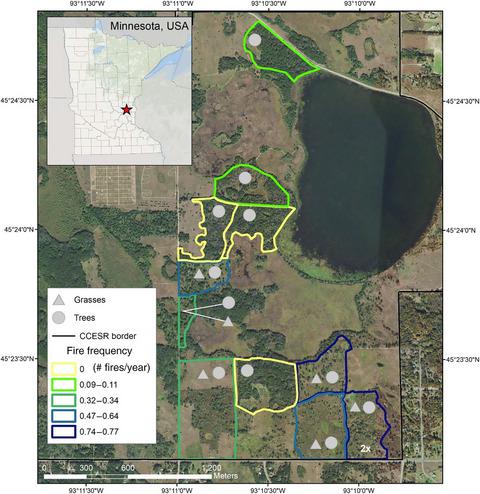Our official English website, www.x-mol.net, welcomes your
feedback! (Note: you will need to create a separate account there.)
Frequent burning causes large losses of carbon from deep soil layers in a temperate savanna
Journal of Ecology ( IF 5.3 ) Pub Date : 2020-01-09 , DOI: 10.1111/1365-2745.13351 Adam F. A. Pellegrini 1, 2 , Kendra K. McLauchlan 3 , Sarah E. Hobbie 4 , Michelle C. Mack 5 , Abbey L. Marcotte 3 , David M. Nelson 6 , Steven S. Perakis 7 , Peter B. Reich 8, 9 , Kyle Whittinghill 10
中文翻译:

频繁燃烧会在温带稀树草原的深层土壤中造成大量碳损失
更新日期:2020-01-09
Journal of Ecology ( IF 5.3 ) Pub Date : 2020-01-09 , DOI: 10.1111/1365-2745.13351 Adam F. A. Pellegrini 1, 2 , Kendra K. McLauchlan 3 , Sarah E. Hobbie 4 , Michelle C. Mack 5 , Abbey L. Marcotte 3 , David M. Nelson 6 , Steven S. Perakis 7 , Peter B. Reich 8, 9 , Kyle Whittinghill 10
Affiliation

|
- Fire activity is changing dramatically across the globe, with uncertain effects on ecosystem processes, especially below‐ground. Fire‐driven losses of soil carbon (C) are often assumed to occur primarily in the upper soil layers because the repeated combustion of above‐ground biomass limits organic matter inputs into surface soil. However, C losses from deeper soil may occur if frequent burning reduces root biomass inputs of C into deep soil layers or stimulates losses of C via leaching and priming.
- To assess the effects of fire on soil C, we sampled 12 plots in a 51‐year‐long fire frequency manipulation experiment in a temperate oak savanna, where variation in prescribed burning frequency has created a gradient in vegetation structure from closed‐canopy forest in unburned plots to open‐canopy savanna in frequently burned plots.
- Soil C stocks were nonlinearly related to fire frequency, with soil C peaking in savanna plots burned at an intermediate fire frequency and declining in the most frequently burned plots. Losses from deep soil pools were significant, with the absolute difference between intermediately burned plots versus most frequently burned plots more than doubling when the full 1 m sample was considered rather than the top 0–20 cm alone (losses of 98.5 Mg C/ha [−76%] and 42.3 Mg C/ha [−68%] in the full 1 m and 0–20 cm layers respectively). Compared to unburned forested plots, the most frequently burned plots had 65.8 Mg C/ha (−58%) less C in the full 1 m sample. Root biomass below the top 20 cm also declined by 39% with more frequent burning. Concurrent fire‐driven losses of nitrogen and gains in calcium and phosphorus suggest that burning may increase nitrogen limitation and play a key role in the calcium and phosphorus cycles in temperate savannas.
- Synthesis . Our results illustrate that fire‐driven losses in soil C and root biomass in deep soil layers may be critical factors regulating the net effect of shifting fire regimes on ecosystem C in forest‐savanna transitions. Projected changes in soil C with shifting fire frequencies in savannas may be 50% too low if they only consider changes in the topsoil.
中文翻译:

频繁燃烧会在温带稀树草原的深层土壤中造成大量碳损失
- 火灾活动在全球范围内发生着巨大变化,对生态系统过程(尤其是地下过程)的影响不确定。通常认为由火引起的土壤碳(C)的损失主要发生在上层土壤层,因为地上生物量的反复燃烧限制了有机物输入地表土壤。但是,如果频繁燃烧会减少根系生物量向深层土壤中输入C的碳,或者通过淋洗和底涂刺激C的碳损失,则可能会导致土壤深层的C碳损失。
- 为了评估火灾对土壤C的影响,我们在一个温带橡木大草原上进行了为期51年的火灾频率操纵实验,采样了12个样地,其中规定燃烧频率的变化已使密闭冠层森林的植被结构产生了梯度。在经常烧毁的土地上,将未烧毁的土地转为开盖大草原。
- 土壤碳储量与火灾频率呈非线性关系,在稀疏草原中,土壤碳以最高燃烧频率达到峰值,而在最频繁燃烧的土地中下降。从深层土壤池中流失的损失很大,当考虑整个1 m样本而不是仅靠顶部0–20 cm时,中间燃烧田与最频繁燃烧田之间的绝对差额增加了一倍以上(损失98.5 Mg C / ha [在整个1 m和0-20 cm的层中分别为[-76%]和42.3 Mg C / ha [-68%]。与未燃烧的森林地块相比,最频繁燃烧的地块在整个1 m样本中的C减少65.8 Mg C / ha(-58%)。顶部20厘米以下的根生物量也下降了39%,燃烧频率更高。
- 综合。我们的结果表明,森林深层土壤中土壤C和根部生物量的失火驱动可能是调节森林-热带稀树草原过渡期火势转移对生态系统C的净效应的关键因素。如果仅考虑表层土壤的变化,随着稀树草原中火频率的变化,土壤C的预计变化可能太低50%。











































 京公网安备 11010802027423号
京公网安备 11010802027423号